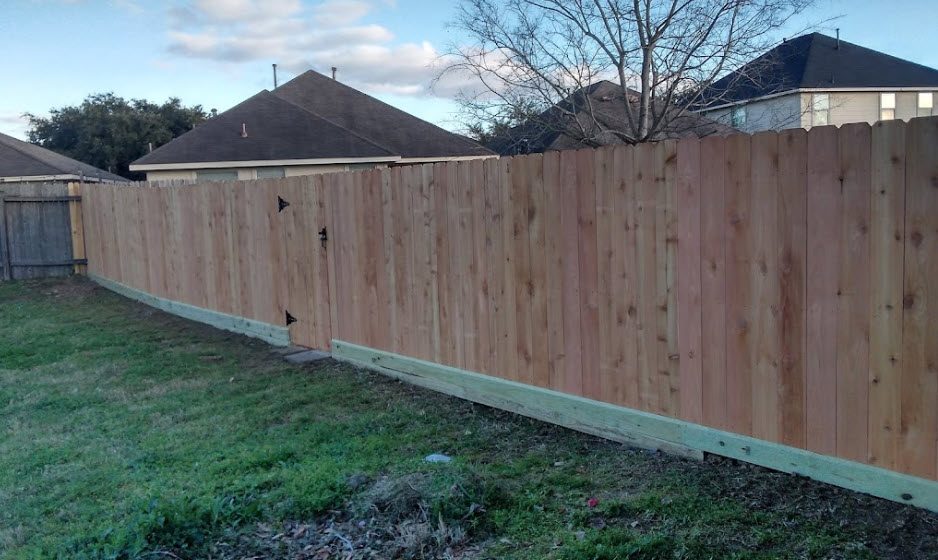How New Fence Installation Can Boost Curb Appeal and Property Value
When we consider home improvements, a new fence installation might not be the first thing that comes to mind. However, it’s a powerful way to enhance our property’s curb appeal and potentially increase its value. We’ve seen how the right fence can transform a home’s exterior, creating a striking first impression and offering practical benefits like privacy and security. But there’s more to it than just putting up any barrier. The style, material, and even color of our fence can make a significant difference in how it impacts our home’s overall aesthetic and market appeal. Let’s explore why this often-overlooked upgrade deserves our attention.

Key Points
- A well-designed fence enhances a property’s aesthetic appeal, creating a more attractive and inviting exterior.
- Fences provide privacy and security, which are desirable features for potential homebuyers.
- Quality fencing materials and proper installation can increase a home’s perceived value in the real estate market.
- Strategically landscaped fences integrate with the property, improving overall curb appeal and outdoor living spaces.
- Fence installations typically recoup 50-70% of their cost at resale, offering a positive return on investment.
Choosing the Right Fence Style
Choosing the right fence style is an essential first step in any new fence installation project. We need to contemplate both aesthetic appeal and functionality when making this decision. Our choice should complement our home’s architecture and blend with the neighborhood’s overall look.
We’ve got several options to explore. Wood fences offer a classic, warm appearance and can be customized with various stains and designs. They’re perfect for creating a cozy, traditional atmosphere, and their nostalgic appeal can enhance the charm of any property.
Vinyl fences, on the other hand, provide a clean, modern look with minimal maintenance. They’re ideal for those of us who want a long-lasting, low-upkeep solution.
For a more open feel, we might ponder aluminum or wrought iron fences. These allow visibility while still defining property lines and adding a touch of elegance.
Chain-link fences are budget-friendly and practical, especially for larger properties or when security is a primary concern.
We shouldn’t overlook privacy needs. Tall, solid fences can create a secluded backyard oasis, while shorter, more open designs maintain a friendly, welcoming front yard.
Material Matters
Once we’ve settled on a fence style, it’s crucial to ponder the materials that will bring our vision to life. We’ll need to take into account factors like durability, maintenance requirements, and cost when making our selection.
Wood fences offer a timeless look and can be painted or stained to match our home’s exterior, but they require regular upkeep. It’s vital to regularly inspect wood fences for damage and decay to ensure their longevity.
Vinyl fencing is low-maintenance and comes in various colors, though it may not have the same charm as natural materials.
For those of us seeking strength and longevity, metal fences are an excellent choice. Wrought iron provides an elegant, timeless appearance but can be prone to rust. Aluminum offers similar aesthetics with better rust resistance. Chain-link fencing is budget-friendly and practical but may not enhance curb appeal as much as other options.
We should also take into consideration composite materials, which blend wood fibers with plastic to create a durable, low-maintenance option that mimics the look of wood. By carefully weighing the pros and cons of each material, we can choose the one that best suits our needs, budget, and aesthetic preferences while boosting our property’s value and curb appeal.
Color and Finish Options
The color and finish of our fence can make or break its overall aesthetic appeal. When choosing the right hue and texture, we need to take into account our home’s exterior, landscaping, and neighborhood aesthetic. A well-chosen color and finish can seamlessly integrate the fence into our property’s overall design, enhancing curb appeal and potentially increasing property value. Additionally, selecting the appropriate style, such as ornamental wood fences, can further elevate the aesthetic and artistic expression of our outdoor space.
Here are four popular color and finish options to contemplate:
- Natural wood stains
Natural wood stains allow us to maintain the beauty of the wood grain while protecting the fence from the elements.
- Solid color paints
Solid color paints offer a wide range of options to match or complement our home’s exterior.
- Weathered or distressed finishes
Weathered or distressed finishes can create a rustic, lived-in look that’s perfect for certain architectural styles.
- Two-tone combinations
Two-tone combinations can add visual interest and depth to our fence design.
When selecting a color and finish, we should also take into consideration maintenance requirements and longevity. Some options may require more frequent touch-ups or reapplication, while others offer longer-lasting protection. By carefully weighing our options, we can choose a color and finish that not only looks great but also stands the test of time.
Landscaping Integration
When integrating a new fence with landscaping, we’ll explore three key areas: complementary plant selection, fence-friendly garden design, and coordinated color schemes.
We’ll examine how to choose plants that enhance your fence’s appearance and create a cohesive look for your property. Our focus will be on practical strategies to seamlessly blend your fence with your outdoor space, maximizing both aesthetic appeal and functionality.
Complementary Plant Selection
Along with your new fence installation, complementary plant selection plays a pivotal role in enhancing your property’s overall aesthetic appeal. We’ll guide you through choosing the right plants to harmonize with your fence and create a cohesive outdoor space. Take into account factors like climate, soil type, and sunlight exposure when selecting plants that will thrive alongside your fence.
To create a visually appealing landscape, we recommend focusing on:
- Height variation: Mix tall shrubs, medium-sized plants, and ground covers
- Texture diversity: Combine plants with different leaf shapes and sizes
- Color coordination: Choose plants that complement your fence color
- Seasonal interest: Include plants that bloom or change color throughout the year
We’ll help you strike the perfect balance between privacy and openness by strategically placing plants along your fence line. Evergreen shrubs can provide year-round screening, while flowering vines can soften the fence’s appearance.
Don’t forget to take into account maintenance requirements when selecting plants – low-maintenance options are ideal for busy homeowners. By carefully choosing complementary plants, we’ll create a seamless flow between your fence and the surrounding landscape, boosting your property’s curb appeal and value.
Fence-Friendly Garden Design
Integration lies at the heart of fence-friendly garden design, seamlessly blending your new fence with the surrounding landscape. We’ll explore how to create a cohesive outdoor space that enhances both your fence and garden. Consider these key elements:
| Design Element | Purpose | Examples |
|---|---|---|
| Vertical Planting | Softens fence lines | Climbing roses, ivy, trellises |
| Layered Borders | Creates depth | Tall shrubs, mid-height perennials, ground cover |
| Color Coordination | Unifies space | Matching fence color to garden palette |
| Focal Points | Draws attention | Garden art, water features, statement plants |
Coordinated Color Schemes
Building on the concept of fence-friendly garden design, coordinated color schemes play an essential role in creating a harmonious outdoor space. We’ll explore how to integrate your new fence with your landscape’s palette, enhancing both curb appeal and property value.
When selecting colors for your fence, consider these key factors:
- Your home’s exterior colors
- Existing landscape elements
- Neighborhood aesthetics
- Personal style preferences
We’ll start by examining your home’s exterior colors, as these will serve as the foundation for your color scheme.
Next, we’ll assess your landscape’s existing hues, including flowers, foliage, and hardscaping elements. It’s vital to create a cohesive look that ties everything together.
We’ll also take into account your neighborhood’s overall aesthetic. While you want your property to stand out, it should still complement the surrounding area.
Maintenance and Longevity
We’ll now examine the key aspects of maintaining a newly installed fence to guarantee its longevity and continued enhancement to property value.
Regular cleaning and inspection are vital practices that homeowners should incorporate into their routine property maintenance.
Protective treatments and timely repairs play an important role in preserving the fence’s appearance and structural integrity, ultimately safeguarding the investment and its contribution to curb appeal.
Regular Cleaning and Inspection
Regular maintenance is essential for preserving the appearance and structural integrity of your new fence. We recommend establishing a routine cleaning and inspection schedule to safeguard your investment continues to enhance your property’s curb appeal and value. By staying proactive, we can catch minor issues before they become major problems, saving time and money in the long run.
Here’s a list of key maintenance tasks we should perform regularly:
- Thoroughly clean the fence using appropriate methods for the material
- Inspect for signs of damage, such as loose boards, rust, or insect infestations
- Check and tighten any loose hardware or fasteners
- Apply protective coatings or stains as needed to prevent weathering
We should aim to clean and inspect our fence at least twice a year, typically in spring and fall.
For wooden fences, we may need to increase the frequency of inspections and maintenance due to their susceptibility to moisture damage and pest infestations. By working together to keep our fences in top condition, we’re not only protecting our investment but also contributing to the overall aesthetics of our neighborhood.
Protective Treatments and Repairs
Protective treatments and repairs play an essential role in maintaining the longevity and appearance of our new fence installation. We should apply protective sealants or stains to wooden fences every 2-3 years to guard against moisture, UV damage, and insect infestations. For metal fences, we’ll need to address rust spots promptly by sanding and applying rust-inhibiting paint.
Let’s not overlook small repairs, as they can prevent larger issues down the line. We should replace loose or damaged boards, tighten loose screws, and realign posts as needed.
For chain-link fences, we’ll want to repair any bent or broken links and [guarantee] the tension remains appropriate.
In areas prone to severe weather, we might consider additional protective measures. Installing fence caps can prevent water from seeping into wooden posts, while wind braces can reinforce sections exposed to high winds.
Neighborhood Harmony
Beyond enhancing individual properties, new fence installations can play an important role in fostering neighborhood harmony. We’ve seen how well-planned fencing can create a cohesive look throughout a community, contributing to a sense of unity and shared aesthetic. When neighbors collaborate on fence designs, materials, and heights, it often results in a more visually appealing streetscape that benefits everyone.
To promote neighborhood harmony through fencing, we recommend:
- Consulting with neighbors before installation
- Adhering to local homeowners’ association guidelines
- Choosing styles that complement surrounding architecture
- Maintaining fences consistently across property lines
We’ve found that open communication about fencing plans can prevent misunderstandings and conflicts.
It’s also an opportunity to discuss shared maintenance responsibilities for fences on property lines. By working together, neighbors can create a unified appearance that enhances the entire street’s curb appeal.
Return on Investment
While neighborhood harmony is a significant benefit of new fence installations, many homeowners are also interested in the financial aspects of this investment. We acknowledge that you’re seeking a return on your fence installation, and we’re here to provide some insights.
Typically, a new fence can recoup 50-70% of its cost when you sell your home. This ROI varies depending on factors like material quality, design, and local market conditions.
We’ve observed that wood fences often offer the best balance between cost and value, while ornamental metal fences can command higher returns in upscale neighborhoods.
It’s important to note that a fence’s value isn’t just in its resale potential. We need to take into account the long-term benefits, such as increased privacy, enhanced security, and improved curb appeal. These factors can make our homes more attractive to potential buyers, potentially leading to faster sales and higher offers.
Frequently Asked Questions
Do I Need a Permit to Install a New Fence?
We typically need permits for new fence installations. It’s essential we check with our local zoning office or homeowners’ association. They’ll guide us through the process, ensuring we comply with regulations and avoid potential issues down the line.
How Long Does a Typical Fence Installation Take?
We typically complete fence installations in 1-3 days, depending on the size and complexity of the project. Factors like terrain, materials, and weather can affect our timeline. We’ll provide a detailed estimate after evaluating your specific needs.
Can I Install a Fence on a Sloped Yard?
We’re here to help with your sloped yard challenge! Yes, you can install a fence on uneven terrain. We’ll use special techniques like stepping or raking to guarantee your fence looks great and functions properly. Let’s tackle this together!
What’s the Average Lifespan of Different Types of Fences?
We’ve found that fence lifespans vary greatly. Wood fences typically last 15-20 years, while vinyl can endure 20-30 years. Chain-link fences often reach 20-30 years, and wrought iron can last 50+ years with proper maintenance. Let’s explore these options together.
How Close to My Property Line Can I Install a Fence?
We’re all neighbors here, like trees in a forest. Let’s talk property lines and fences. Generally, we can install fences right on our property line, but it’s essential we check local zoning laws and homeowners’ association rules first.
Takeaway
We’ve explored how new fence installation can transform your property’s curb appeal and value. The impact is undeniable – it’s like giving your home a facelift! By carefully selecting style, material, color, and integrating with landscaping, we’re not just building barriers; we’re crafting masterpieces. Remember, a fence that harmonizes with the neighborhood and stands the test of time isn’t just an investment; it’s a financial windfall waiting to happen. Let’s fence our way to property perfection!








